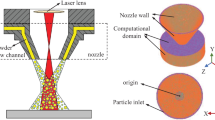Abstract
Laser cladding with coaxial powder feeding is one of the new processes applied to produce well bonding coating on the component to improve performance of its surface. In the process, the clad material is transported by the carrying gas through the coaxial nozzle, generating gas-powder flow. The powder feeding process in the coaxial laser cladding has important influence on the clad qualities. A 3D numerical model was developed to study the powder stream structure of a coaxial feeding nozzle. The predicted powder stream structure was well agreed with the experimental one. The validated model was used to explore the collision behavior of particles in the coaxial nozzle, as well as powder concentration distribution. It was found that the particle diameter and restitution coefficient greatly affect the velocity vector at outlet of nozzle due to the collisions, as well as the powder stream convergence characteristics below the nozzle. The results indicated a practical approach to optimize the powder stream for the coaxial laser cladding.
Similar content being viewed by others
References
Majumdar J D, Manna I. Laser material processing. Int Mater Rev, 2011, 56: 341–388
Dubourg L, Archambeault J. Technological and scientific landscape of laser cladding process in 2007. Surf Coat Tech, 2008, 202: 5863–5869
Li S X, Yu G, Zhang J C, et al. Single-row laser beam with energy strengthened ends for continuous scanning laser surface hardening of large metal components. Sci China-Phys Mech Astron, 2013, 56: 1074–1078
Toyserkani E, Khajepour A, Corbin S. Laser Cladding. Boca Raton: CRC Press, 2005. 1–40
Smurov I, Doubenskaia M, Zaitsev A, Comprehensive analysis of laser cladding by means of optical diagnostics and numerical simulation. Surf Coat Tech, 2013, 220: 112–121
Pinkerton A J, Li L. Modeling powder concentration distribution from a coaxial deposition nozzle for laser-based rapid tooling. J Manuf Sci, 2004, 126: 33–41
Pinkerton A J. An analytical model of beam attenuation and powder heating during coaxial laser direct metal deposition. J Phys D-Appl Phys, 2007, 40: 7323–7334
Liu J C, Li L J. Effects of powder concentration distribution on fabrication of thin-wall parts in coaxial laser cladding. Opt Laser Technol, 2005, 37: 287–292
Yang N. Concentration model based on movement model of powder flow in coaxial laser cladding. Opt Laser Technol, 2009, 41: 94–98
Lin J. Numerical simulation of the focused powder streams in coaxial laser cladding. J Mater Process Tech, 2000, 105: 17–23
Zhu G X, Li D C, Zhang A F, et al. Numerical simulation of metallic powder flow in a coaxial nozzle in laser direct metal deposition. Opt Laser Technol, 2011, 43: 106–113
Zekovic S, Dwivedi R, Kovacevic R. Numerical simulation and experimental investigation of gas-powder flow from radially symmetrical nozzles in laser-based direct metal deposition. Int J Mach Tool Manu, 2007, 47: 112–123
Tabernero I, Lamikiz A, Ukar E, et al. Numerical simulation and experimental validation of powder flux distribution in coaxial laser cladding. J Mater Process Tech, 2010, 210: 2125–2134
Wen S Y, Shin Y C, Murthy J Y, et al. Modeling of coaxial powder flow for the laser direct deposition process. Int J Heat Mass Tran, 2009, 52: 5867–5877
Balu P, Leggett P, Kovacevic R. Parametric study on a coaxial multi- material powder flow in laser-based powder deposition process. J Mater Process Tech, 2012, 212: 1598–1610
Haider A, Levenspiel O. Drag coefficient and terminal velocity of spherical and nonspherical particles. Powder Technol, 1989, 58: 63–70
Du W, Bao X, Xu J, et al. Computational fluid dynamics (CFD) modeling of spouted bed: Influence of frictional stress, maximum packing limit and coefficient of restitution of particles. Chem Eng Sci, 2006, 61: 4558–4570
Author information
Authors and Affiliations
Corresponding authors
Rights and permissions
About this article
Cite this article
Liu, H., He, X., Yu, G. et al. Numerical simulation of powder transport behavior in laser cladding with coaxial powder feeding. Sci. China Phys. Mech. Astron. 58, 104701 (2015). https://doi.org/10.1007/s11433-015-5705-4
Received:
Accepted:
Published:
DOI: https://doi.org/10.1007/s11433-015-5705-4




